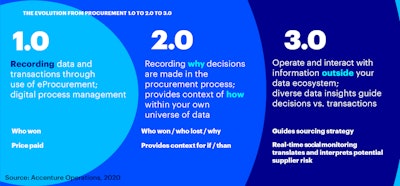
From the year 2000 to 2020, e-procurement or electronic procurement has changed, updated and been innovated to keep up with the pace of each newer generation of people and technology. The internet has transformed and became modern day technology that wasn’t as efficient 20 years ago. Now, it’s a powerful tool to save money on commodity goods and specialized parts and services.
Many companies have upgraded their way of reaching out to buyers and innovated the opportunities for companies to measure growth. Companies sell product and interact with buyers electronically getting the consumers their product, and still provide customer service.
“Amazon Business offers buyers the option to create purchasing approval workflows to manage spend, while easily viewing and taking action on pending orders. Additionally, analytics into spend across PO numbers, invoices, suppliers, account groups, categories and more, provides greater transparency. The multi-seller store also assists buyers in identifying new small and/or diverse suppliers for meeting their socio-economic purchasing goals,” says an executive from Amazon Business.
For purchasing and supply managers, they gain access to hundreds of millions of products through e-procurement stores and receive more opportunities to achieve discount prices. Single-unit and quantity discounts on millions of eligible items, in addition to dynamic store pricing, helps ensure savings for organizations.
E-procurement is a digital process of procurement, which means that paper order forms, catalogs, etc., and a large part of purchasing work consists of obtaining and comparing supplies, e-procurement solutions can centralize this work.
“The value of this new era of digital procurement is seen in how it’s integrated with people at the point of need," says Kristin Ruehle, who leads procurement business process services for Accenture Operations. "It’s not about digital in isolation but rather about how it’s infused with people and processes to unlock value. For example, manual, routine processes are automated to improve user experience and reduce costs. Real-time insights help guide business stakeholders on day-to-day operations or buying agents on purchasing decisions. New levels of collaboration afforded by cloud-based multi-client platforms transform buyer interactions with suppliers and other third parties.”
Savings and methods
Some advantages to e-procurement is its automation, procurement time, cost and flexibility, and quality. E-procurement has caught the attention of investors, directors, and chief executives but over the past two decades, it has kept their attention by saving companies and organizations money. According to Pierre de la Boulaye, a partner in McKinsey's Paris office, "Intelligent spend engines can, for example, identify similar maintenance parts used by both companies and consolidate vendors. In our work supporting post-merger integration programs, we have seen these tools enable savings of 10% to 12%."
According to a Sana Commerce Survey:
- In 2019, 75% of business-to-business (B2B) buyers purchased goods online
- Across all of the industries surveyed, about one-in-three professional buyers wanted to make $90 or more of their purchases online, and buyers were more likely to work with distributors or manufacturers that offered an excellent e-commerce experience.
“Here are a few examples of recent digital procurement transformations that Accenture has led: A global MedTech leader created a scalable and agile procurement model able to respond to fast-evolving business needs without missing a beat. That resulted in $117M worth of invoice mismatches resolved to prevent overpayment and compliance with buying policies.” says Ruehle.
Word to the wise: Strategize
Procurement, just as with so many other industries, is starting to find its future in the digital world, and, as such, it is important that both B2B suppliers and CPOs alike should be seeking to adapt to the changes in order to engage and capture the increasingly savvy electronic B2B buyers and sellers, and thus increase revenue through capitalizing on this new opportunity of digital growth.
“Today, many companies are stuck in the procurement 1.0 phase. These companies use technology to automate processes and record what has happened: a transaction executed, an invoice paid, an item purchased, a contract signed," adds Ruehle. "And, unfortunately, it’s also marked by systems of record (in the form of software) that generally have made the procurement process overly complex and unpleasant to navigate from a user’s perspective. Some leading procurement organizations are taking this further by digging deeper with technology to understand what happened and why (procurement 2.0). Such insights are crucial to build AI-enabled models to improve future decision-making. Finally, when procurement and the business operate and interact with diverse data sets (outside their data ecosystem), intelligent capabilities will go beyond executing transactions to actually guiding and making business decisions – as we’re beginning to see emerge from procurement 3.0 organizations.”
 According to Accenture Operation, this chart represents the evolutions of procurement from 1.0 to 3.0.Accenture
According to Accenture Operation, this chart represents the evolutions of procurement from 1.0 to 3.0.Accenture
Stop reacting
“For a more convenient and cost-effective e-procurement experience, organizations should have multiple purchasing and payment plan options to choose from based on the size of their business," says a spokesperson from Amazon Business. "By tailoring discounts, payment terms, delivery and more, for small, medium, and large organizations, supply managers gain a purchasing experience that meets their individual needs. E-procurement should also be a familiar retail experience for supply managers. The most convenient online B2B stores offer features and capabilities that resemble the consumer shopping experience, providing buyers with tools they’re already comfortable using.”
- Eliminate waste or create value. These are the only ways to achieve sustainable benefits.
- Match e-procurement solutions to the characteristics of the spend.
- Decide if, how and when you can become a market maker. Leverage existing e-procurement products. Don’t spend the time and money to develop something proprietary.
- Don’t underestimate the internal changes required to realize benefits.
“Five key elements to creating an effective digital procurement strategy include: data, technology toolbox, intuitive user experience, talent expertise, processes, and procedures.” says Ruehle.
By embracing online procurement directly, purchasing and supply management professionals can not only participate in change but also use it as a catalyst to reorder their career and its trajectory. Like any other acquired skill, it just requires the right training and mindset.










